The Intel Kaby Lake-X i7 7740X and i5 7640X Review: The New Single-Threaded Champion, OC to 5GHz
by Ian Cutress on July 24, 2017 8:30 AM EST- Posted in
- CPUs
- Intel
- Kaby Lake
- X299
- Basin Falls
- Kaby Lake-X
- i7-7740X
- i5-7640X
Shadow of Mordor
The next title in our testing is a battle of system performance with the open world action-adventure title, Middle Earth: Shadow of Mordor (SoM for short). Produced by Monolith and using the LithTech Jupiter EX engine and numerous detail add-ons, SoM goes for detail and complexity. The main story itself was written by the same writer as Red Dead Redemption, and it received Zero Punctuation’s Game of The Year in 2014.
A 2014 game is fairly old to be testing now, however SoM has a stable code and player base, and can still stress a PC down to the ones and zeroes. At the time, SoM was unique, offering a dynamic screen resolution setting allowing users to render at high resolutions that are then scaled down to the monitor. This form of natural oversampling was designed to let the user experience a truer vision of what the developers wanted, assuming you had the graphics hardware to power it but had a sub-4K monitor.
The title has an in-game benchmark, for which we run with an automated script implement the graphics settings, select the benchmark, and parse the frame-time output which is dumped on the drive. The graphics settings include standard options such as Graphical Quality, Lighting, Mesh, Motion Blur, Shadow Quality, Textures, Vegetation Range, Depth of Field, Transparency and Tessellation. There are standard presets as well.
We run the benchmark at 1080p and a native 4K, using our 4K monitors, at the Ultra preset. Results are averaged across four runs and we report the average frame rate, 99th percentile frame rate, and time under analysis.
For all our results, we show the average frame rate at 1080p first. Mouse over the other graphs underneath to see 99th percentile frame rates and 'Time Under' graphs, as well as results for other resolutions. All of our benchmark results can also be found in our benchmark engine, Bench.
MSI GTX 1080 Gaming 8G Performance
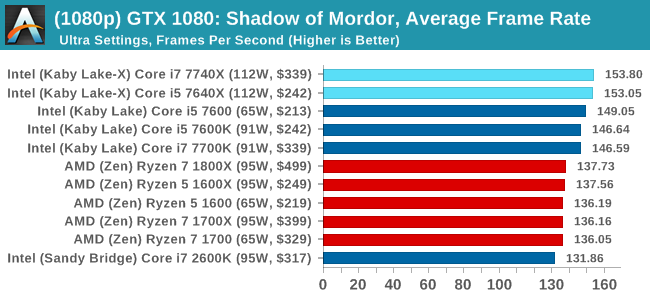
1080p

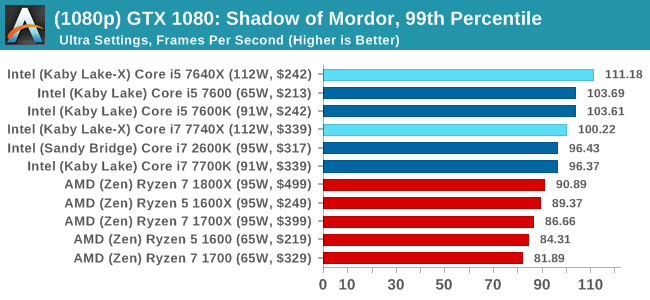
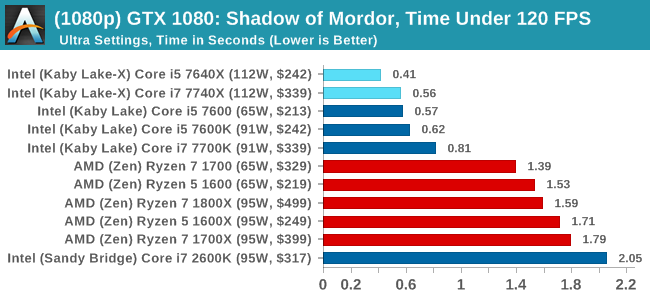
4K
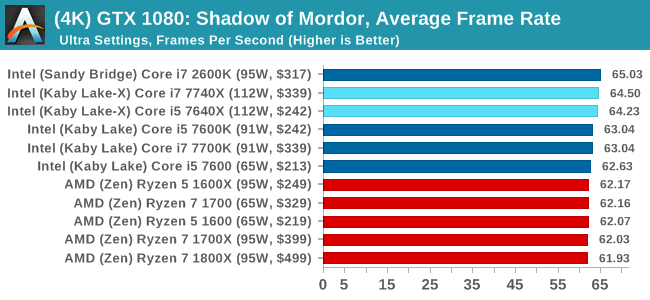
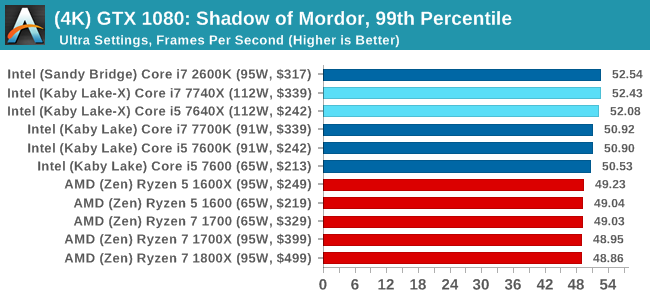
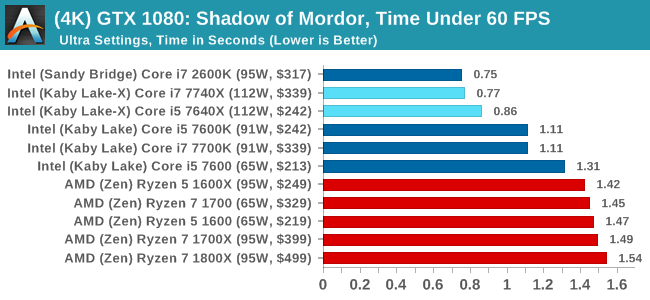
ASUS GTX 1060 Strix 6GB Performance
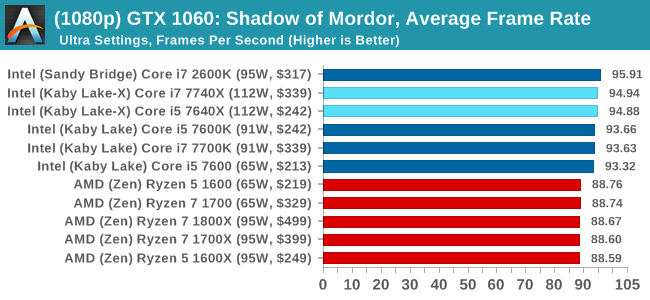
1080p

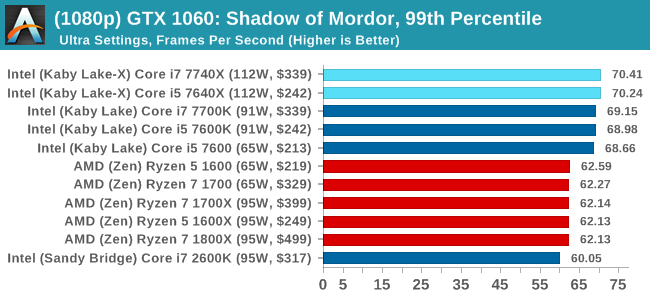
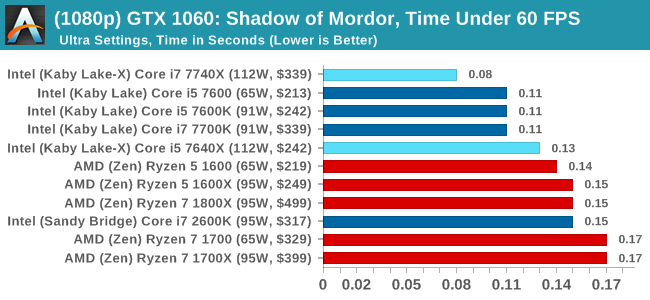
4K
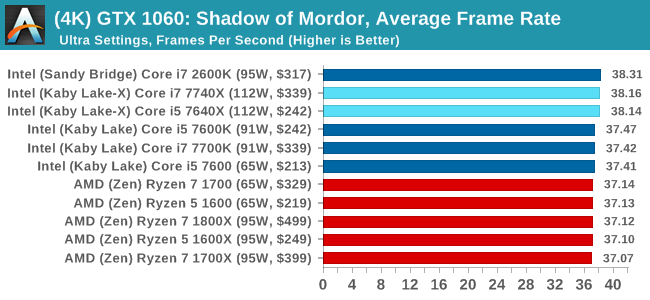
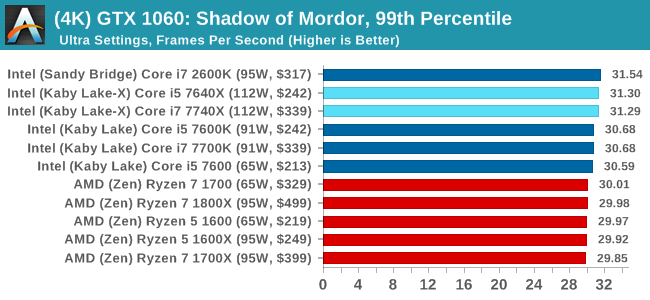
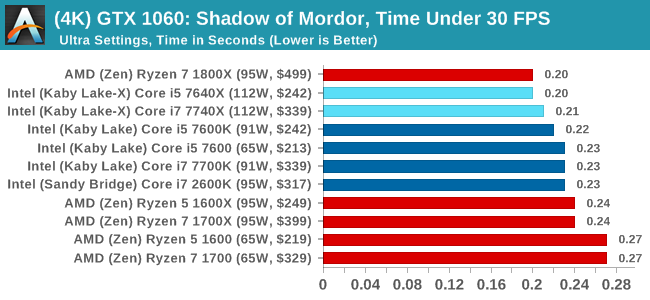
Sapphire R9 Fury 4GB Performance

1080p


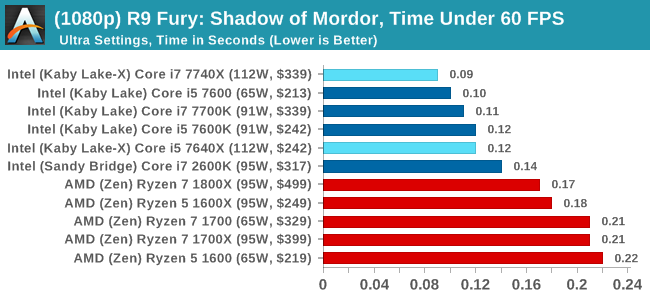
4K
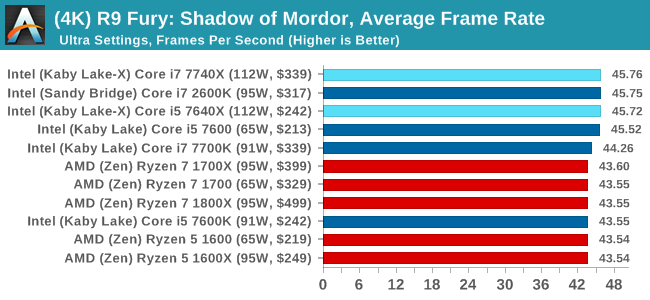
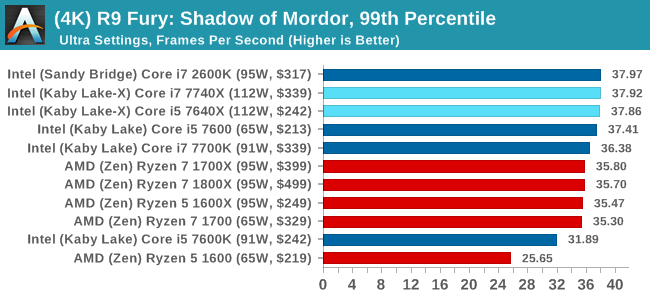

Sapphire RX 480 8GB Performance
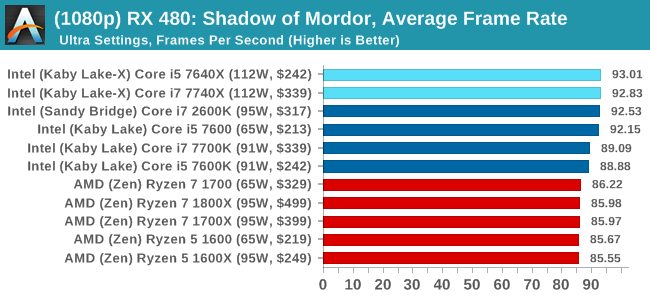
1080p

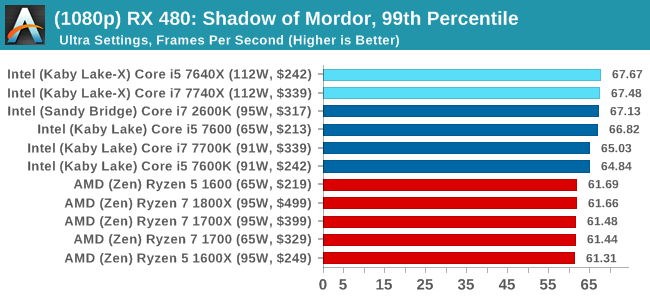
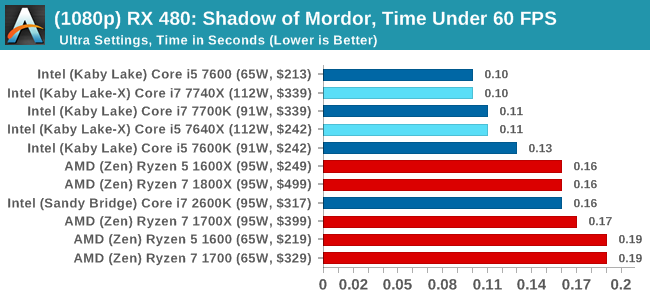
4K
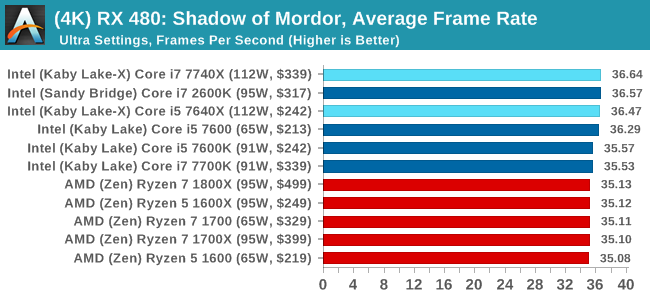
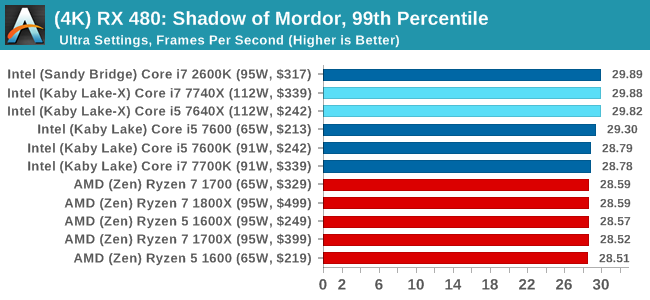
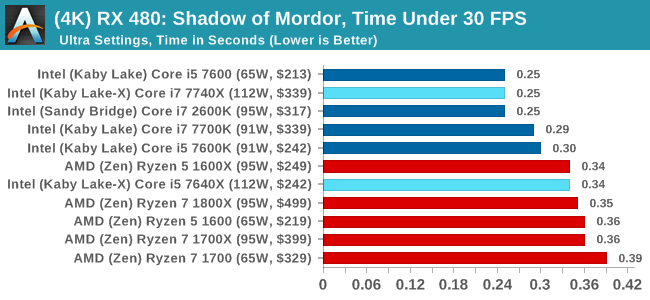
Shadow of Mordor Conclusions
Again, a win across the board for Intel, with the Core i7 taking the top spot in pretty much every scenario. AMD isn't that far behind for the most part.












176 Comments
View All Comments
Gothmoth - Tuesday, July 25, 2017 - link
so why not test at 640x480... shifts the bottleneck even more to the cpu... you are kidding yourself.silverblue - Tuesday, July 25, 2017 - link
Not really. If the GPU becomes the bottleneck at or around 1440p, and as such the CPU is the limiting factor below that, why go so far down when practically nobody games below 1080p anymore?Zaxx420 - Monday, July 24, 2017 - link
"Over the last few generations, Intel has increased IPC by 3-10% each generation, making a 30-45% increase since 2010 and Sandy Bridge..."I have an old Sandy i5 2500K on an Asus Z68 that can do 5GHz all day on water and 4.8 on air. I know it's ancient IP...but I wonder if it could hold it's own vs a stock clocked Skylake i5? hmmmm...
hbsource - Tuesday, July 25, 2017 - link
Great review. Thanks.I think I've picked the best nit yet: On the Civ 6 page, you inferred that Leonard Nimoy did the voiceover on Civ 5 when he actually did it on Civ 4.
gammaray - Tuesday, July 25, 2017 - link
it's kind of ridiculous to see the Sandy bridge chip beating new cpus at 4k gaming...Zaxx420 - Tuesday, July 25, 2017 - link
Kinda makes me grin...I have an old Sandy i5 2500K on an Asus Z68 that can do 5GHz all day on water and 4.8 on air. I know it's ancient IP...but I wonder if it could hold it's own vs a stock clocked Skylake i5? hmmmm...
Mugur - Tuesday, July 25, 2017 - link
Much ado about nothing. So the best case for 7740 is Office applications or opening PDF files? The author seems to have lost the sight of the forest because of the trees.Some benchmarks are odd, some are useless in the context. I watched the YouTube version of this: https://www.techspot.com/review/1442-intel-kaby-la... and it looked like a more realistic approach for a 7740k review.
Gothmoth - Tuesday, July 25, 2017 - link
well i guess intel is putting more advertising money on anandtech.otherwise i cant´t explain how an overpriced product with heat problems and artificial crippled pci lanes on an enthusiast platform(!) can get so much praise without much criticism.
jabber - Tuesday, July 25, 2017 - link
I miss the days when you saw a new bunch of CPUs come out and the reviews showed that there was a really good case for upgrading if you could afford to. You know a CPU upgrade once or twice a year. Now I upgrade (maybe) once every 6-7 years. Sure it's better but not so much fun.Dragonstongue - Tuesday, July 25, 2017 - link
Intel wins for the IO and chipset, offering 24 PCIe 3.0 lanes for USB 3.1/SATA/Ethernet/storage, while AMD is limited on that front, having 8 PCIe 2.0 from the chipset.Funny that is, seeing as AM4 has 16 pci-e lanes available to it unless when go down the totem pole those lanes get segregated differently , even going from the above table Intel is offering 16 for x299not 24 as you put directly into words, so who wins in IO, no one, they both offer 16 lanes. Now if you are comparing via price, x299 is obviously a premium product, at least compare to current AM4 premium end which is x370 chipset, pretty even footing on the motherboards when compared similar "specs" comparing the best AMD will offer in the form of x399, it makes the best "specs" of x299 laughable.
AMD seems to NOT be shortchanging pci-e lanes, DRAM ability (or speed) functional, proper thermal interface used etc etc.
Your $ by all means, but seriously folks need to take blinders off, how much raw power is this "95w TDP" processors using when ramped to 5+Ghz, sure in theory it will be the fastest for per core performance, but how long will the cpu last running at that level, how much extra power will be consumed, what price of an acceptable cooler is needed to maintain it within thermal spec and so forth.
Interesting read, but much seems out of context to me. May not like it, but AMD has given a far better selection of product range this year for cpu/motherboard chipsets, more core, more threads, lots of IO connectivity options, fair pricing overall (the $ value in Canada greed of merchants does not count as a fault against AMD)
Am done.